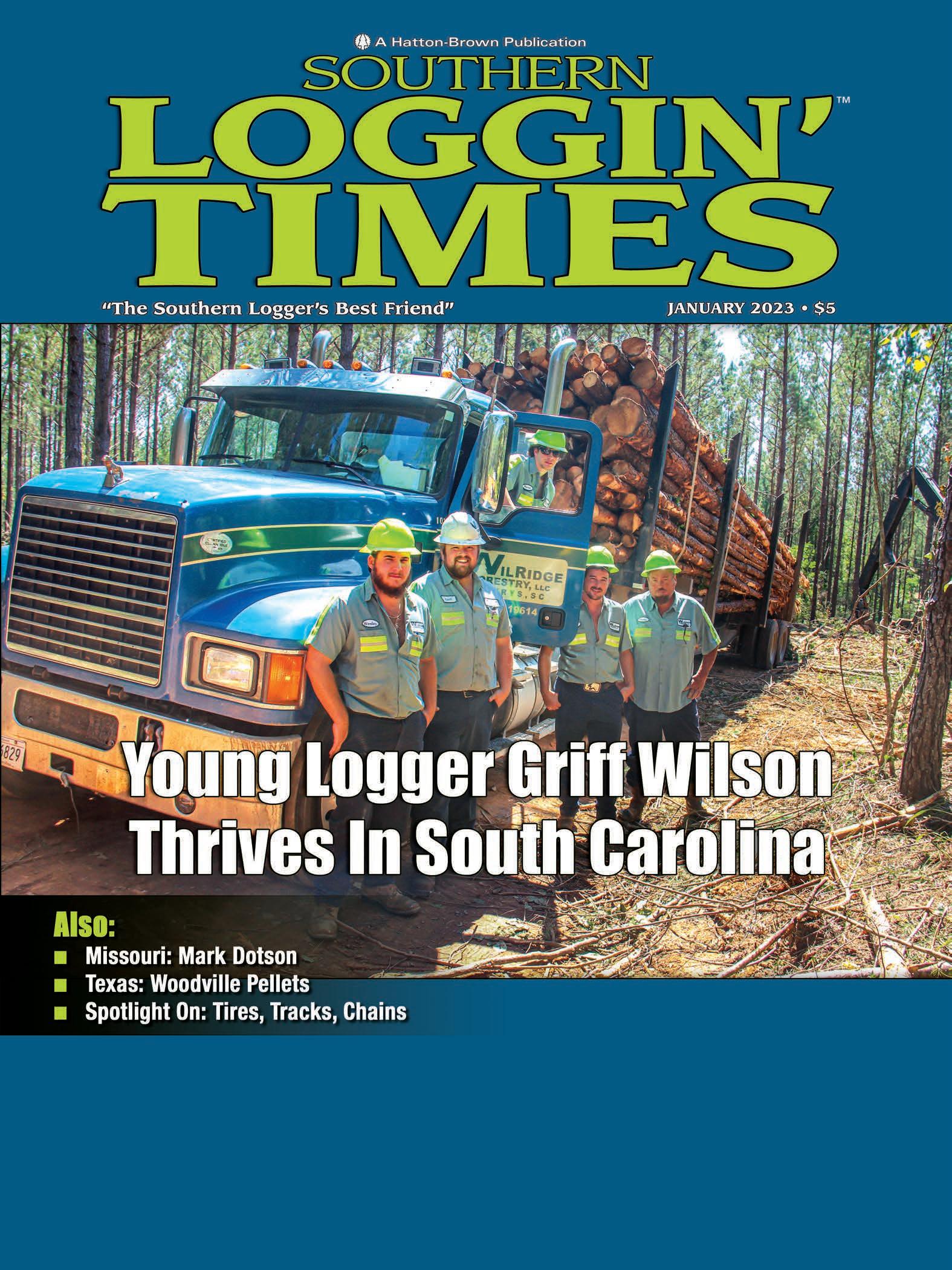

CLICK HERE IF YOU HAVE NOT ALREADY OPTED IN!
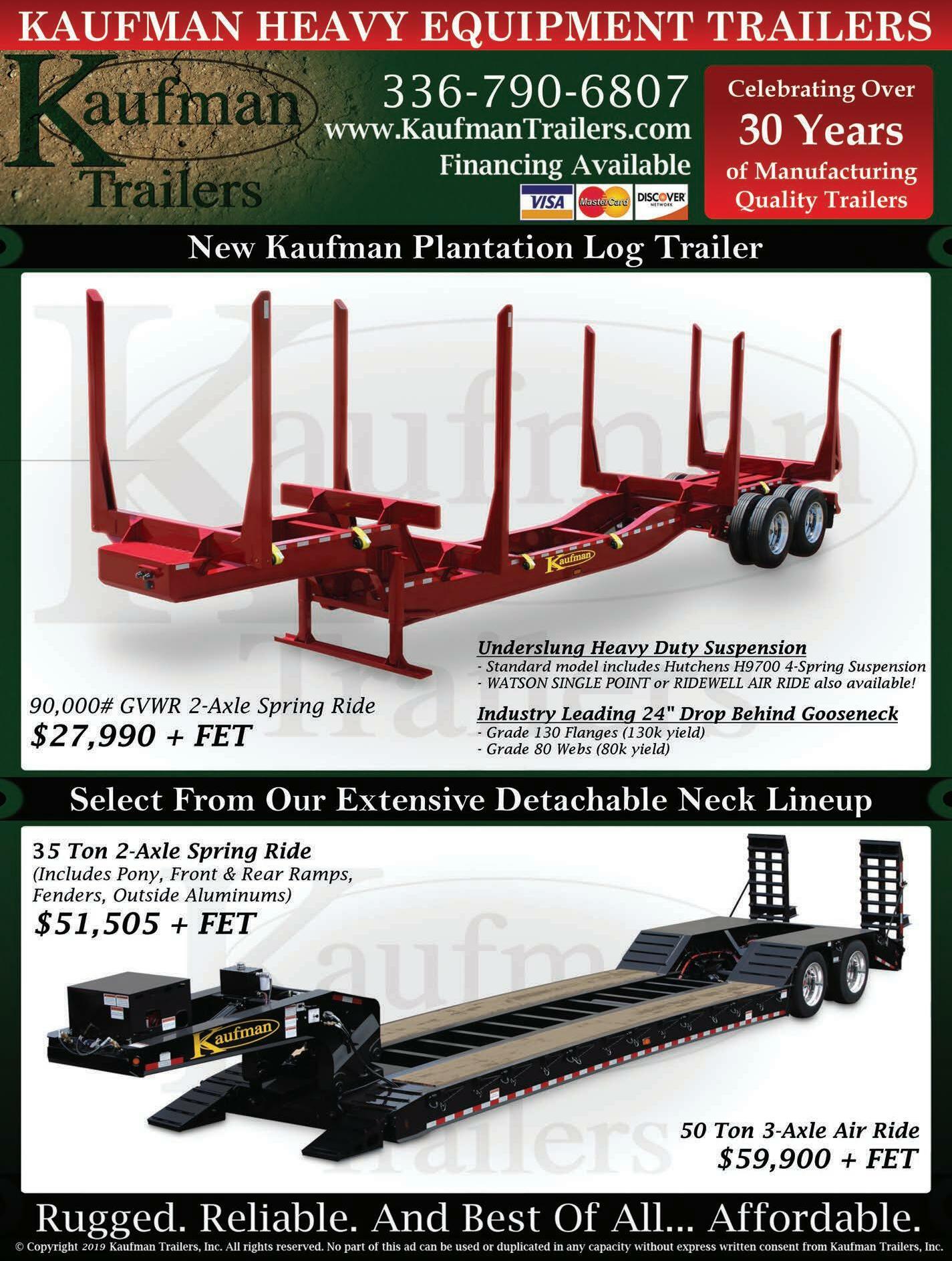
CLICK HERE IF YOU HAVE NOT ALREADY OPTED IN!

CLICK HERE IF YOU HAVE NOT ALREADY OPTED IN!
Phone: 334-834-1170 Fax: 334-834-4525
www.southernloggintimes.com

Publisher David H. Ramsey Chief Operating Officer Dianne C. Sullivan
Editor-in-Chief Rich Donnell Senior Editor Dan Shell Managing Editor David Abbott Senior Editor Jessica Johnson
Publisher/Editor Emeritus David (DK) Knight Art Director Cindy Segrest Ad Production Coordinator Patti Campbell Circulation Director Rhonda Thomas Online Content/Marketing Jacqlyn Kirkland
ADVERTISING
Eastern U.S. Kathy Sternenberg Tel: 251-928-4962 • Fax: 334-834-4525 219 Royal Lane Fairhope, AL 36532
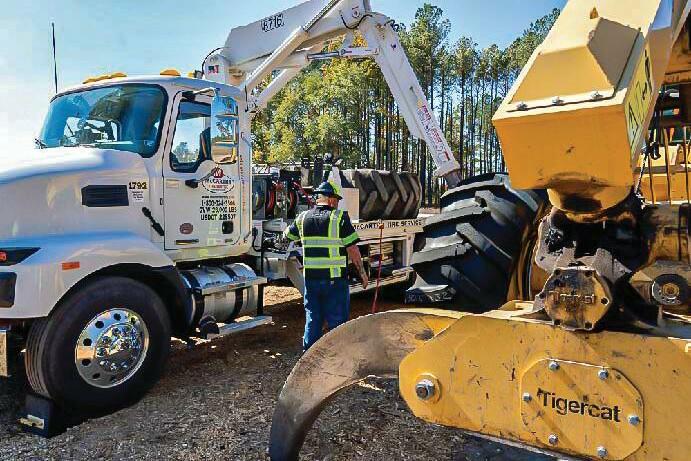


E-mail: ksternenberg@bellsouth.net Midwest USA, Eastern Canada John Simmons Tel: 905-666-0258 • Fax: 905-666-0778 32 Foster Cres. Whitby, Ontario, Canada L1R 1W1
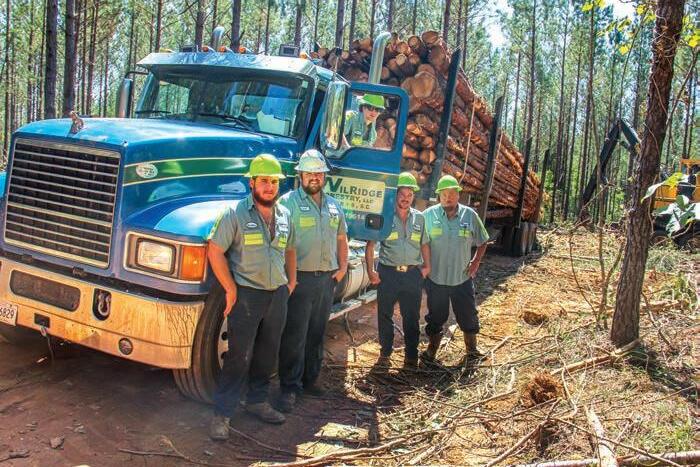
E-mail: jsimmons@idirect.com Western Canada, Western USA Tim Shaddick Tel: 604-910-1826 • Fax: 604-264-1367 4056 West 10th Ave. Vancouver, BC V6L 1Z1
E-mail: twshaddick@gmail.com Kevin Cook Tel: 604-619-1777
lordkevincook@gmail.com
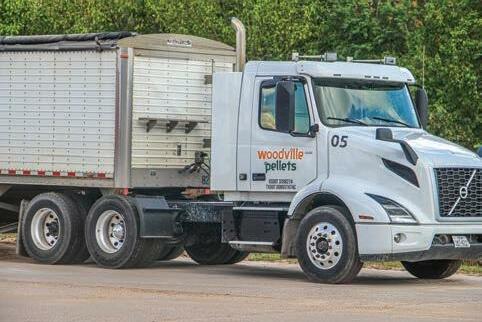
CONTACTS DISPLAY SALES
CLASSIFIED ADVERTISING Bridget DeVane Tel: 1-800-669-5613 • Tel 334-699-7837 Email:
Vol. 52 No. 1 (Founded in 1972—Our 604th Consecutive Issue) January 2023 A Hatton-Brown Publication Member Verified Audit Circulation Southern Loggin’ Times (ISSN 0744-2106) is published monthly by Hatton-Brown Publishers, Inc., 225 Hanrick St., Montgomery, AL 36104. Subscription Information—SLT is sent free to logging, pulpwood and chipping contractors and their supervisors; managers and supervisors of corporate-owned harvesting operations; wood suppliers; timber buyers; wood procurement and land management officials; industrial forestry purchasing agents; wholesale and retail forest equipment representatives and forest/logging association personnel in the U.S. South. See form elsewhere in this issue. All non-qualified U.S. subscriptions are $65 annually; $75 in Canada; $120 (Airmail) in all other countries (U.S. funds). Single copies, $5 each; special issues, $20 (U.S. funds). Subscription Inquiries TOLL-FREE 800-669-5613; Fax 888-611-4525. Go to www.southernloggintimes.com and click on the subscribe button to subscribe/renew via the web. All advertisements for Southern Loggin’ Times magazine are accepted and published by Hatton-Brown Publishers, Inc. with the understanding that the advertiser and/or advertising agency are authorized to publish the entire contents and subject
deems inappropriate. Copyright ®
All rights
Reproduction
in part without written permission
mailing offices.
POSTMASTER: Send address changes to: Southern Loggin’ Times, P.O. Box
FEATURES 4 ● JANUARY 2023 ● Southern Loggin’ Times Other Hatton-Brown publications: ★ Timber Processing ★ Timber Harvesting ★ Panel World ★ Power Equipment Trade ★ Wood Bioenergy At
14 One Big Log 20 Bright Future Ahead 22 Spotlight On: Tires, Tracks, Etc. Bulletin Board. . . . . . . . . . . . . . . . . . . 6 From The Backwoods Pew. . . . . . . 30 Industry News Roundup. . . . . . . . . 34 Truck Safety Focus. . . . . . . . . . . . . . 38 Safety Focus. . . . . . . . . . . . . . . . . . . 40 Coming Events. . . . . . . . . . . . . . . . . 46 CLICK HERE IF YOU HAVE NOT ALREADY OPTED IN!
E-mail:
International Murray Brett Tel: +34 96 640 4165 +34 96 640 4048 58 Aldea de las Cuevas • Buzon 60 03759 Benidoleig (Alicante), Spain E-mail: murray.brett@abasol.net
bdevane7@hotmail.com
matter thereof. The advertiser and/or advertising agency will defend, indemnify and hold Hatton-Brown Publishers, Inc. harmless from and against any loss, expenses, or other liability resulting from any claims or lawsuits for libel violations or right of privacy or publicity, plagiarism, copyright or trademark infringement and any other claims or lawsuits that may arise out of publication of such advertisement. Hatton-Brown Publishers, Inc. neither endorses nor makes any representation or guarantee as to the quality of goods and services advertised in Southern Loggin’ Times. Hatton-Brown Publishers, Inc. reserves the right to reject any advertisement which it
2023.
reserved.
in whole or
is prohibited. Periodicals postage paid at Montgomery, Ala. and at additional
Printed In USA.
2419, Montgomery, AL 36102-2419
WilRidge Forestry in South Carolina, young logger Griff Wilson built on a farming background to grow his business a lot in 10 short years. He now fields two logging crews and a timber dealership. Pictured here, from left: Wesley Cope, Griff Wilson, Kevin Mock, Will Sadler and Doug Hawkins. Story begins on Page 8. (Photo by May Donnell)
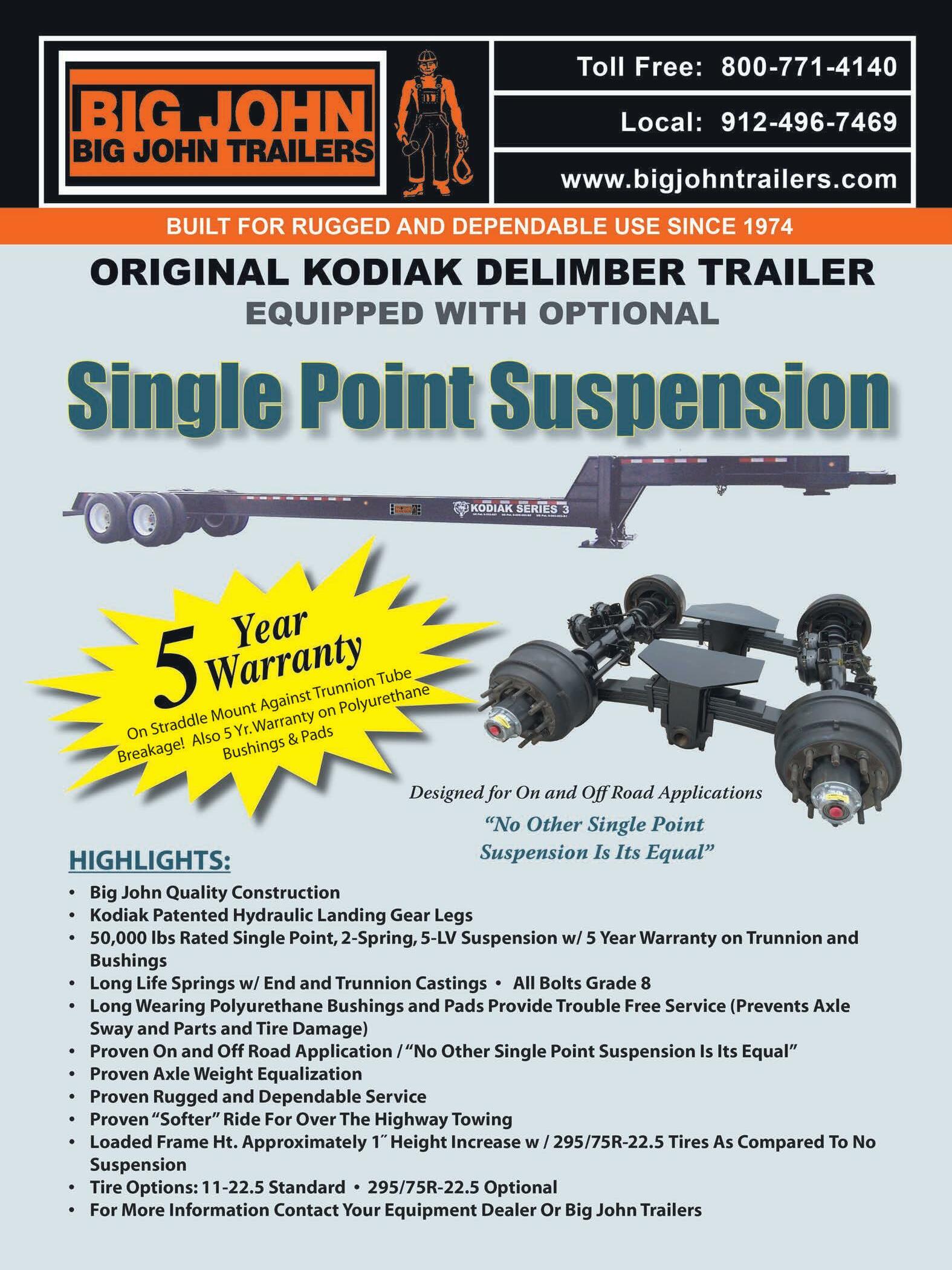
CLICK HERE IF YOU HAVE NOT ALREADY OPTED IN!
Nature At Work: Remarkable!

















6 l JANUARY 2023 l Southern Loggin’ Times
CLICK HERE IF YOU HAVE NOT ALREADY OPTED IN!

CLICK HERE IF YOU HAVE NOT ALREADY OPTED IN!
Not All Old And Gray
LOWRYS, SC
riff Wilson, 28, began his logging career in the summer of 2012 with a chain saw and old-school chain near the farm in Lowrys, in Chester County, South Carolina, where he grew up. He had just graduated from high school and was headed in the fall to North Carolina State University in Raleigh. By that time he was a seasoned farm hand, having gone to work baling wheat straw at age 12. He managed to put together 10 log loads that summer and with the proceeds and help from his father, he purchased a used skidder. Each summer for the next four years, he worked that skidder.

He’s upped his production considerably since that time. And then some. The company now averages 80 loads per week, 45% sawlogs and 55% pulpwood. Wilson estimates his crews cut or thin some 40 to 50 acres

8 l JANUARY 2023 l Southern Loggin’ Times
CLICK HERE IF YOU HAVE NOT ALREADY OPTED IN!
■ Griff Wilson is a prime example of younger loggers making a go of it. ★
ly, really careful. We didn’t have a 20-year reputation behind us so we knew we had to quickly prove ourselves and keep proving ourselves.”
Wilson’s forest management degree at N.C. State provided some credibility, especially for someone starting out in the logging business


stand the silvicultural goals behind logging operations.”
Wilson, who started with two employees, now runs two crews within a 50-mile radius of Lowrys, including Chester, York, Lancaster, Fairfield, Union and Kershaw counties.
Timber buyer Brennon Lipscomb
ing ourselves with each job we do.”
Operations
SLT caught up with Wilson at work with one of his two crews on a vast pine plantation just a few miles outside of Chester. This crew had

CLICK HERE IF YOU HAVE NOT ALREADY OPTED IN!
pellet mill is north of Charlotte, NC, which means having to deal with hauling past the sprawling metro area.

“There’s not a chipper anywhere within these three counties,” Wilson says, referring to Chester, Fairfield and York counties. “There’s no economic sense in hauling to a pellet mill 100 miles away.”


And speaking of economic sense, Wilson admits it’s a daily challenge keeping up with rising costs. “Seems like everything we use has gone up by 20% over the past several years,” he says. “Oil, parts, labor and insurance, you name it. We have to be so careful, especially because being young, you’re paying on everything you’ve got.”
Maintenance costs are kept to a minimum at least, because Wilson does about 75% of it. “I usually spend Saturdays in the shop we share with my dad. It is a significant savings that we’re able to do the routine maintenance ourselves.”
The company is fairly self-sufficient in that it handles the oil changes, chain sharpening and even washing its own fleet of Mack trucks. When parts are needed, WilRidge buys from Carquest in Chester or from their dealers. Insurance is purchased through Swamp Fox Insurance Agency in Monck’s Corner.
Fortunately, Wilson is blessed with a talented family. Griff’s wife, Caroline, runs the office and oversees payroll, insurance, trucking and whatever else comes up. She
10 l JANUARY 2023 l Southern Loggin’ Times CLICK HERE IF YOU HAVE NOT ALREADY OPTED IN!

CLICK HERE IF YOU HAVE NOT ALREADY OPTED IN!
has a master’s degree in agricultural and extension education from N.C. State but her own career path took a sharp turn. After her schooling and marriage to Griff she came into the company because there was a need.
“I never thought I’d be doing this kind of work but here I am,” she says. “The job is difficult but we’ve adjusted to it.”
Occasionally, Caroline is also needed to run to Charlotte or Rock Hill for parts. “We had an intern and he did the parts runs when he
was with us but he went back to school,” she says with a sigh. Under her supervision, WilRidge began offering benefits like health insurance and 401K options, even though she admits there are few takers. “We do have some who take advantage.”
Caroline may not be quite as active in the business this spring and summer, with their first child due in April.
At the loading deck, it doesn’t take long to notice Wilson’s prefer-
ence when it comes to hauling vehicles. The outfit operates with seven Mack trucks—model years 2005, 2006, 2007, 2013, 2014, 2015 and 2023. Company drivers are Will Sadler, Robert Prather, Boogey Man, Doug Hawkins and William “Papa Cool” Hemphill.
WilRidge Forestry trucks its goods to the New-Indy mill in Catawba, Boise Cascade in Chester, Stella-Jones in Whitmire, GeorgiaPacific in Prosperity, International Paper in Eastover & Santuc, CM
Tucker in Pageland, Canfor Southern Pine in Camden and Associated Hardwoods in Gaffney.
Hauling is accomplished with five 2018 Pitts log trailers and a Pitts lowboy.

Wilson buys his Tigercat logging equipment from Wright and Von Dennis at Tidewater. He splits the equipment between his two threeman crews, which generally operate on separate tracts.
Skidders include a 2020 Tigercat 620E, a 2017 Tigercat 620E and 2016 Tigercat 620E. Skidder operators are Kevin Mock and Jim Comer.
The outfit has two loaders, a 2017 Tigercat 234B and 2015 Tigercat 234. Loader operators are Morris Montgomery and Timothy Bolus.
Feller-bunchers are a 2016 Tigercat 720G and 2019 Tigercat 720G. Crew foreman Wesley Cope operates one cutter and Henry Glenn runs the other.
Also included in the equipment inventory are three bull dozers, a 2001 Cat D5MLGP, a 2001 Cat D5C XL Series 3 and a 1986 Cat D5H. The crews each use a set of Maxiload ccales. There is a 2005 Chambers Delimbinator, 1982 John Deere 672A motor grader and two Ford service trucks, a 2014 Ford F350 and a 2015 Ford F-350.
The second WilRidge crew that SLT visited is one Wilson calls his “younger crew.” They were a halfmile from the Broad River in western York County and were first thinning on a 60-acre pine tract. Pulpwood was hauled to the New-Indy mill in Rock Hill.
Meanwhile, along with daily reminders about individual safety concerns related to the day’s operations, Wilson’s goal is to do monthly safety tailgate meetings. All company drivers (log truck and service truck) go through a safety training when hired and two additional driver safety trainings each year.
In relatively short order, Griff Wilson has turned a chain saw and an old chain into a double crew force to be reckoned within the region where he lives.
“I knew early on I wanted to be in the logging business,” Wilson says. “With some help along the way I’ve been able to achieve what I set out to do. Not that it gets any easier.”
Indeed the biggest challenges heading into the new year remain continuously rising operating costs and finding/training quality operators. But Wilson is optimistic.
“We hope that we may be able to continue to develop new operators, strategically grow production and take advantage of potential new opportunities in the market.” SLT
12 l JANUARY 2023 l Southern Loggin’ Times CLICK HERE IF YOU HAVE NOT ALREADY OPTED IN!

CLICK HERE IF YOU HAVE NOT ALREADY OPTED IN!
BIG JOB
Mark Dotson, 59, the owner of Tri Rivers Enterprise, runs two crews. Both crews work in a variety of tract types, but when Southern Loggin’ Times caught up with them last fall, the Tri Rivers team had a very atypical job. On that day, instead of deep in the woods off of a rural dirt road, SLT found Dotson’s equipment at Lord’s Park in downtown Harrisonville, a suburb of Kansas City. This bid job, with timber marked by private forestry consultants, was full of large walnut trees, and a few oaks. One oak in particular presented an intriguing logistical challenge. Near the back end of the park, this one measured seven feet diameter on the butt.


14 l JANUARY 2023 l Southern Loggin’ Times
★ CLICK HERE IF YOU HAVE NOT ALREADY OPTED IN!
By counting the growth rings, the Tri Rivers team estimated the tree to be about 390 years old. If their count was accurate, that would place it having first sprung up sometime in the 1630s, about 20 years after the time of Shakespeare and the first publication of the King James Bible, 10 years after the pilgrims landed at Plymouth Rock, and almost 150 years before the U.S. transitioned from British colonies to independent nation. That’s how long this tree has been sitting there in Missouri—since 200 years before it was Missouri.


Unfortunately, the tree had reached the end of its life cycle, so Harrisonville needed someone to remove it before it finished dying and became a problem, along with several others on the site. Dotson won the bid.



The tract wasn’t large in terms of acreage, but with such large trees (this was the biggest but many others were above average), the amount of fiber per acre was well worth the time. “It was a really high-end, unique job,” Dotson says. “We get a few specialty trees. We don’t seek them out but they happen to come up on our job from time to time. It’s hard to get a large amount of them, though, because there just are not a lot of these kinds of trees left.”
It took three tanks of chain saw fuel just to cut the butt; the top had to be taken down with a bucket truck to keep it from breaking; while standing, its estimated height was 100 ft. Chain saws aren’t in common use on this mechanized crew, but it’s a good thing someone still knows how to use one skillfully when it’s needed.
Felling this beast was just half the battle; getting it loaded and hauled away would be no mean feat. No grapple would be wide enough to grip it, no boom strong enough to lift it unaided, and no regular log trailer large enough to hold it. But the team came up with and executed a plan that, eventually, got the job done. A John Deere 437 loader and 648H skidder rolled it up onto a lowboy a little at a time. The knuckleboom used grapple and chains to

CLICK HERE IF YOU HAVE NOT ALREADY OPTED IN!
Crew supervisor Blake Sedgwick (left,center) had to keep the teeth sharp and his skills sharper; mechanic Eric Brownlee (right) helped set chains from the loader grapple around the log.
alternated pulling with its grapple and pushing with its blade on the other end. Finally, they maneuvered it onto the flatbed.
It was an impressive display of skill and coordination by the team; not just any group of operators could have handled it so well. “We have really good help,” Dotson affirms. Eric Brownlee (full-time mechanic), Blake Sedgwick (Dotson’s son-inlaw and supervisor over day-to-day operations in the woods), Huey Jacobs (truck driver) and Andy Harper (Dotson’s nephew) were onsite to help; they represent a lot of years of combined experience.
Dotson didn’t haul this behemoth to a mill; what mill could handle it? He held onto it, planning to market it via social media and see what kind of interest it attracted. He figured a few high-end tabletop makers might put it to good use. He paid the city $3,000 for the tree; it ended up fetching him $12,000.
Equipment
Between the two crews, Tri Rivers uses two John Deere 648H rubber tired grapple skidders and another 648L that runs on a forestry track system from G&R Manufactured Solutions. Dotson doesn’t run this machine on every job, but in steep
comes in handy, he affirms. “We have worked it in up to 35% grade,” he says.
On each crew, the skidders pull to either a 437E John Deere loader with CSI slasher/delimber package, or to a self-loader truck. Tri Rivers has 18 trucks all together, mostly Peterbilts with a couple of Western Stars. Seven are quad-axles with Rotobec self-loaders pulling double bunk pup trailers. For felling, Tri Rivers recently acquired a new TimberPro 755D with 2900 intermittent head
573 with single point hot saw.
Dotson buys John Deere equipment from Murphy Tractor & Equipment Co. in Kansas City, and bought the TimberPro from Bush Forestry in Huntingdon, Tenn.





With those G&R tracks on the skidder and the TimberPro, Tri Rivers is not too limited in terms of when, where and in what conditions they can work. “With the equipment we have today, we just don’t have very many down days,” he reflects. In fact, he considers, “We need more down time to work on it.” Tri
needed.
The logger prefers Mobil synthetic motor and hydraulic oil. “They have a really good blend that can take the heat; we run it in everything we have.” He reports only routine problems with newer Tier 4 machines—DEF tank sensors and such. “Most of the time they don’t act up but once in a while they do. If you are relying on just one piece of equipment you’re in trouble,” he believes; that is why he keeps several spares and backups.
Dotson used to operate seven days a week, but has mostly cut back to five now. “It is hard on the help,” he explains. “I have found out if you work too many days, they are worn out and you don’t get as much production for the time spent, so you might as well just cut it back. Now if it is a rainy season, when it is too wet to work sometimes, then we might run seven days a week to make up for the time lost.”
Timber
Tri Rivers logs private timberland, relying on an established reputation with landowners, who often contact Dotson directly when they want their property cut. He buys a
Rivers has a shop for routine R&M, and Brownlee also has a Peterbilt service truck to handle urgent repairs in the field when
16 l JANUARY 2023 l Southern Loggin’ Times
The skidder pulled with the grapple,then turned around and pushed with the blade,with nephewAndy Harper lending his eyes from the ground to help guide the machine operators.
CLICK HERE IF YOU HAVE NOT ALREADY OPTED IN!
Left to right:Andy Harper,Huey Jacobs,Mark Dotson,Blake Sedgwick,Eric Brownlee

CLICK HERE IF YOU HAVE NOT ALREADY OPTED IN!
lot of his own timberland as well, and buys some tracts from consulting foresters.
“Our timber varies so much,” Dotson reflects. “We don’t have a lot of large tracts. It is mostly smaller private land, but once in a while we get on a really good tract of timber where one crew can put out 10 loads a day.”



The crews work within a 200mile radius from home base; Dotson would prefer to stay within 100 miles, but with so much row crop farming in the area, he’s found it necessary to go outside that range and move around a lot to keep busy during the summer.
Dotson also travels to work disaster relief after hurricanes or major tornadoes. Back 12 years ago, he went all the way to Alabama after the deadly Tuscaloosa tornado in 2011, and his brother did the same a month later closer to home in Joplin. Instead of storm timber removal, they focus on debris cleanup, subcontracting under AshBritt Environmental, a national turnkey rapid-response disaster recovery and special environmental services contractor based in Florida.
Family Background
Dotson is a third generation logger. “My father and my grandfather sawmilled and logged years ago down in Arkansas, down in the Buffalo River range,” he says. “It was really hard to make a living there, so dad moved to Missouri in the early ’60s. It has been tough at times but we keep trying to find another niche and keep going.”
Mark worked with his dad and older brother Mike through high school and for a year or two after. Then he and Mike struck out on their own, working together for about a year before branching off separately. Mike started his company, Timberline Trading, and Mark started Tri Rivers Enterprise. Their younger brother Tim also followed with his own company, Dotson and Sons. Their oldest sibling, a sister, has her own business, too, in catering and formal wear rentals.
Mark and wife Kim have two adult daughters, Ashley and Danielle, and several grandchildren. Ashley’s husband Blake (they have three kids) works with his father-inlaw at Tri Rivers, supervising operations in the woods day-to-day.
Danielle and her husband Garrett are in row crop farming, working a few thousand acres of corn and beans. Kim serves as secretary for Tri Rivers, handling office paperwork. “She does an awesome job with that,” Dotson says. SLT
18 l JANUARY 2023 l Southern Loggin’ Times CLICK HERE IF YOU HAVE NOT ALREADY OPTED IN!

CLICK HERE IF YOU HAVE NOT ALREADY OPTED IN!
By Jessica Johnson
WOODVILLE, Tex.
Plagued by neverending drama—from financing to fire—the former Texas Pellets facility here and its nearby port facility never saw the consistency that many other industrial wood pellet operations in the pine-rich U.S. South have experienced over the last decade. Instead, it battled engineering issues, machinery issues, staffing concerns and then finally a bankruptcy.
When Baltics-based Graanul Invest, one of the world’s largest and most reliable wood pellet producers, purchased the mothballed six-year-old plant at auction in 2019, to be blunt, the facility was a mess. Still, it had an untapped potential. But first, some of the lingering legal messes had to be cleared by the administration. Then the familiar song of COVID-related delays killed some of the company’s timelines for re-start. But, as they say, the past is the past and the future, well, the future for Woodville Pellets, as the operation is now called, is bright.

And it starts with recent industry veteran hires Jason Ansley as Vice President of U.S. Operations and Earl Herndon as General Manager of both the Port of Port Arthur facility (which was included in the purchase) and the Woodville site. The pair, having worked together for another manufacturer, have an easy comradery and clear vision of what they want the facility to achieve. Both see what the plant can be and want to get there—while also recognizing the process will take some time.
“The path we are on is going to be bumpy. There are things that will be up and down. We’re going to find something we didn’t expect,” Ansley says of the process to bring the facility to Graanul’s world-leading standards. But he’s quick to point out the team in place is going to help them get there together.
Herndon echoes him by saying that with all transitions there are pain points, and turnover happens, but the knowledge base with the 78 employees, some of whom have been with the facility since commissioning, is unmatched. And the team will stay focused and reach its
Right Track
aspirations as long as no one, including the two at the top, gets overwhelmed.
Adding, “It’s always going to be about people; that triggers everything else. You focus on people and you get everything else done.” Herndon has only been on the job since late summer, but putting people first has already helped the plant actualize some of its goals.
Herndon is also incredibly invested in the team because this is his first facility to manage. He says he had gotten out of the industry when Ansley came calling to chat. Once his steel toes hit the ground and the sweat started coming, he knew he wanted in.
“I love the energy of the facility, but I also love the ability to be active here. You can affect real change here,” Herndon says. “You’re on the ground floor, but there’s also Jason’s leadership. He is really understanding if we want to change something or try something different. He will talk with us about it, get the details and let us go do it.” This perspective and open line of communication has brought the team success in data reporting and becoming much more aware of possible maintenance and processes that can help the plant run more efficiently, and strive to reach its nameplate capacity of 500,000 tons annually.
While Ansley and Herndon are leading the way in Texas, they are not on an island, and are definitely not without support from their head office in Estonia.
European Influence
Although Graanul Invest is a relative newcomer to the North American landscape, the company is wellestablished as the second largest pellet producer in Europe with 11 pellet plants and six combined heat and power plants operating in Estonia, Latvia and Lithuania. The U.S. facility brings Graanul’s pellet production capacity to 2.7 million metric tons. Ansley reports that Graanul has a good balance in that the team overseas is willing to help out, send people over, pick up the phone and support the U.S. team, but also is
willing to allow the U.S. operation to take point and work through the process and get things done on their own. Herndon says the Graanul teams in Europe are very conservative in their thinking, and like to think things all the way through before making suggestions—an approach he respects deeply.
Ansley, who has spent time at the European plants, says the culture that Graanul has worked hard to build is evident. Employees are methodical in their approach to the care and upkeep of the plant’s machinery and structures and invested in the work the company is doing. That’s exactly the way he wants Woodville’s culture to become. He says, “You can tell it was not an overnight process; they invested time and money in getting it right and now culturally, they are invested in sustaining it.”
Herndon was not able to make the trip abroad, but from talking with other managers, watching videos Ansley and others have taken, he says he got a good feel for the operations, and loves the way they are organized. He echoes Ansley that it was clearly not an overnight process but something he certainly wants to reach in Texas—
even if that means moving deliberately and recognizing the discipline needed to get to the point where everything doesn’t have to run fullspeed all the time. Instead, Herndon is having the team focus on small pieces of the single points of failure that have been identified, or areas that need cleanliness attention, get them handled and reach sustainability. Then move on to the next portion of the process. For Herndon and Ansley, it’s all about the sustainability of the plant—a plant they’ve only been working with for right around six months as a team, and a plant that Graanul has only had control over for three years.
“It’s an interesting spot to be in. This plant is nearly 10 years old. It obviously went through a bankruptcy. Graanul has only owned the facility for three years. In the grand scheme of things, that is not a whole lot of time,” Ansley says. “The facility has good bones with the layout and equipment.” Woodville has to get the right people in place, the right systems in place and then strategically invest in upgrades where it makes sense, he adds.
The European plants put more emphasis on stability, Ansley notes, than on just throwing around invest-
20 ● JANUARY 2023 ● Southern Loggin’ Times
★ CLICK HERE IF YOU HAVE NOT ALREADY OPTED IN!
■ After a troubled start, Woodville Pellets looks poised for success with new management and buyout.
ments. “They do not run around and just tape something up and hope that it lasts for six months. They stop and fix it. They have redundancies built in. Earl and I are going through a list of where our single points of failures are and working through that. But it is too early to commit to next steps on projects. Because they are definitely out there and the company is very supportive of investing in the success of the plant.”
Ansley reiterates that this will not be an all at once process. There have been several projects that have been completed since the purchase, including air emissions control enhancement and upgrading the wet hammermills. The single most obvious project done by Graanul is pouring concrete and building a maintenance shop that wasn’t previously on site. Herndon and Ansley also added stairs to the Port of Port Arthur. Herndon says these projects aren’t, on face value, going to get the company more tons, or reduce costs. But it is about helping people do their jobs and making a better working environment. And that goes a long way culturally in the plant.
Doing The Work
The facility operates four shifts, which gives staff plenty of time to transition from day to night. This includes giving staff every other weekend off, with two weeks on days and then back to nights. “This way you can get your internal clock in order instead of constantly switching shifts. And you always have time to run errands and get
those kinds of things done, while still having your weekends back,” Herndon says of the shift change Ansley made.
The changes to the shifts are part of the bigger emphasis Herndon and Ansley put on employee experience. Herndon explains, “We made some key internal moves. A lot of people have been here for years, through the ups and downs. They are really dedicated. If I have a question about a part, Keith Mahaffey has the knowledge. We want to invest in them and make their jobs easier. We want to turn this plant around and we want to sustain it.”
Herndon is an electrical engineer by trade and self-proclaimed super nerdy dude, but he’s not afraid to get his hands dirty. He believes the best way to get buy-in is to show he’s willing to do the work. He admits, laughing, that sometimes the employees don’t want him in the thick of it, but he still shows up anyway: “The only way we get to where we want to be is by us all working together, not me and Jason sitting in the high tower yelling down direction about something. It is us on the ground floor, walking the plant, looking at things and making sure people are staying safe.”
Another culture-focused change Ansley and Herndon have implemented is War Room meetings, where each area manager is responsible for reporting their data, written on a white board, and reported on to other managers during a fifteen-minute stand-up meeting. In these meetings, upcoming changes and ideas are discussed and managers are given equal say in what happens—with a twist.
Herndon says one of the area managers, Sonny Patrick, was always coming
up with different ideas, so one day Herndon gave him the go ahead. But he told Patrick he only had this amount of time to complete the action, a little good-natured competition between the areas, as another area was also trying out an idea that day. Herndon gives cushion for the ideas he thinks are better than others. Explaining, “So, when we are in the War Room, and they say this is how long this action is going to take, if they’ve had a great idea, I will give them a little more buffer. They love that because it makes it a little more lighthearted instead of ‘gotta go do this or gotta go do that.’ Any of these ideas, I look at it from an engineering perspective. I am all about trying different things as long as it is not going to violate OEM constraints that will lead to other issues.”
Ansley loves Herndon’s approach to management, and says they are on the same page at (nearly) most turns. Implementing two-hour reporting, KPIs, and daily War Room meetings are things both were accustomed to at other facilities and helps give better visibility in the process and by using them in Woodville help take this plant to the next level.
Ansley points out that the Estonian head office did a really good job of giving Woodville a good foundation and providing good business systems that are automated. As Graanul has a very lean corporate staff, and each plant staff is relatively small, the company has put considerable time and effort into putting systems together that help operators do their job. Graanul has service programs for PM routes that are integrated onto tablets; items that help automate the scale house, tons tracking, fiber procurement, where typically if you were to come into a situation like this—taking a plant out of bankruptcy—there would be lack of organization. Fortunately, Graanul has already set the foundation for a digital factory, and now it
is on the staff at Woodville to use those systems and leverage them.
Process Flow
Woodville operates on a 50/50 mix of lower value stemwood to pre-processed material, 100% southern yellow pine, of which 40% is residual chips from local sawmills, 10% is dust. Once trucks are received through the scale house, they are either dumped by a Phelps dumper to the chip pad or unloaded to the stemwood yard using a Caterpillar 990 wheel loader or LogPro crane. Fuel from the dumper goes onto a reversing belt from the chip pad. Lower quality stemwood is debarked using a LogPro drum debarker and chipped by a CEM chipper.
The chip pad is outfitted with an FMW stacker-reclaimer with screw to rake the pile. Chips are conveyed to another belt, where the pulverized material goes to the Champion wet mill island, complete with Vecoplan pre-screeners that are currently being tweaked to reach operational level, then to the dryer island. Woodville’s dryer island is a dual line TSI system. This includes the heat energy system and dryers as well as the emission control system for the dryers, the wet ESP and RTO. The system was originally supplied over 10 years ago as the first of the new generation of TSI dryer islands that featured Sigma Thermal furnaces and TSI single pass recycle dryers along with newly introduced TSI wet ESP and RTO providing a reliable integrated system from a single source.

Currently, dry material does pass additional processing, with four Vecoplan pre-screeners to help reach targeted chip size of between 88-92% 2 mm chips for producing smaller industrial pellets.
After the Champion dry mills, two Tank Connection dust silos act as more of a buffer between process islands. Part of the

Times ● JANUARY 2023 ● 21
Southern Loggin’
➤ 45 CLICK HERE IF YOU HAVE NOT ALREADY OPTED IN!
The building stands tall,ready to hit its nameplate capacity of 500,000 tons annually.
Spotlight On: Tires, Tracks, Etc.
BKT
BKT is a global player in the Off-Highway tire industry with an extensive product range catering to the most demanding user needs in any off-highway application. The FS 216 tire for the forestry industry has a robust lug design with optimum angle and a wider width to enhance traction and performance for loggers and skidders. It provides excellent cut and chip resistance under the most critical operating conditions and ensures maximum protection against possible damages at any time for a longer tire life. For more information visit www.bkt-tires.com.

Despino’s Tire
Despino’s Tire Service is a family-owned business that opened in 1996 with one truck and one store location. Today Despino’s Tire has 20+ service trucks and serves Arkansas, Alabama, Georgia, Louisiana, Mississippi, and Texas.

We produce customized wheel solutions that complement nearly any type of forestry equipment – including skidders, feller-bunchers, harvesters, forwarders, and log loaders. We’re also the only global manufacturer of both wheels and tires, which means we can offer a complete wheel assembly for your equipment designs.
Exceptional service and customized products have made Despino Tire the leader of off-the-road tires and wheels. Our technicians are available 24/7 to save you time and make your business run more efficiently. All tire techs are OSHA & MSHA certified and receive initiate and ongoing safety

22 ● JANUARY 2023 ● Southern Loggin’ Times
CLICK HERE IF YOU HAVE NOT ALREADY OPTED IN!
Southern Loggin’ Times invited manufacturers of tires, tracks, chains and related components and services to submit editorial for this section.


CLICK HERE IF YOU HAVE NOT ALREADY OPTED IN!
training from our dedicated Safety Manager. Whether it’s on new equipment or installation deep in the woods, our technicians arrive with the replacement tires you need when you need them. Despino’s Tire is a certified contractor through ISNetworld and Avetta platforms.

Despino’s Tire has raised over $250,000 through our Annual Children’s Miracle Network Bass Tournament on Toledo Bend Lake. The 2023 bass tournament will be Sunday, March 12, 2023, Learn more about Despino’s Tire and our annual bass tournament at www.despinotire.com!
Forest Chain Multi-Ring
Forest Chain wide range of ring skidder chains are available in fixed ring, multi ring, and studded with 9/16", 5/8" or 3/4" tag chains to fit all popular tire sizes. Designed to give as much as 60% more traction to your skidder, Forest Chain skidder chains provide quicker skid times, more production and increased bottom line profits. Forest Chain premium multi-ring heavy duty chains offer superior traction and are available in 9/16, 5/8, 3/4, 7/8 and 1 inch. The DoubleDiamond configured chains equipped with U-shaped studs are especially effective in the worst conditions: the deep biting lugs dig deeply into the terrain. Repairs are easy using common welding techniques and materials for longer life. Email forestchain@gmail.com or call 800-288-0887.

Olofsfors
uct lines are ECO-Tracks, Iggesund Forest, Hultdins and Indexator.
Olofsfors is the market leader in bogie tracks for CTL machinery and wheel tracks for skidders and wheeled feller bunchers. Under the brand name ECO-Tracks, Olofsfors offers a wide range of track models and linkage systems for various machine configurations and ground conditions. Most track models are now available in the next generation of curved cross members for increased flotation, less ground disturbance and easier machine turning. The track assortment ranges from traction only, flotation only and all around.
A new addition to the expanding link system offerings is the 29 mm (11/8"). The new 29 mm link system features an increased 29 mm link along with a wider and thicker link hook. It has 37% more material compared to 26 mm (1") resulting in increased lifetime of the tracks. The 29 mm link system has been designed for large forwarders and 6-wheel skidders and is a good option for abrasive soil conditions.
Along with the new link system, Olofsfors has two new cross member profiles. ECO HD and KovaX+ are increased in size over ECO-Track and KovaX respectively. With more material and taller grouzer bars, both are stronger options with more traction. They have been designed for the heaviest machines, most demanding ground conditions and suitable with the largest link systems for optimal life.
On the maintenance side, Olofsfors has developed a new tightening tool called the Centre Mount Tool. It is 4x faster than the standard ratchet tool and
 Olofsfors is a Swedish based company founded in 1762 with North American operations in Brantford, Ontario, Canada. Olofsfors Inc. specializes in attachments and accessories for cut-to-length machinery. The prod-
Olofsfors is a Swedish based company founded in 1762 with North American operations in Brantford, Ontario, Canada. Olofsfors Inc. specializes in attachments and accessories for cut-to-length machinery. The prod-
24 ● JANUARY 2023 ● Southern Loggin’ Times CLICK HERE IF YOU HAVE NOT ALREADY OPTED IN!

CLICK HERE IF YOU HAVE NOT ALREADY OPTED IN!
uses changeable end lugs like the geared mounting tool. This makes it easier and faster to install and re-tighten different track models with one tool.
For more product information, visit www.olofsfors.com
Wallingford’s
Wallingford’s Inc. is now a member of pewag group, and is the North American distributor of pewag forestry traction products. The pewag single wheel tracks are an alternative to traditional tire chains that have been gaining popularity in the southern regions. Pewag builds tracks of exceptional quality, and they are known for the best wear resistance thanks to a special hardening process for the connecting elements. Four horizontal welded on starwave studs provide excellent traction and stability. The innovative starwave profile also provides prolonged lifespan of the studs. Wheel tracks provides excellent tire protection and the broad contact surface helps with floatation on softer terrain.



Wallingford’s Inc. offers BABAC forestry and heavy equipment tire chains that are American made and hand assembled for optimum quality control at our factory in Winslow, Maine. BABAC offers a full line of standard tire chain patterns for skidder, forwarder, tractor and heavy equipment applications. BABAC has computer design capability and we specialize in custom tire chain applications and odd tire sizes. BABAC's Ring chains provide excellent traction for operating in mud or other adverse conditions, and have been popular with our Southern logging customers for many years. All models feature alloy lugs that, unlike most other chains, are butt and wrap welded for unsurpassed strength and durability. Tag and cross chains are made from through hardened
10B21 Boron Alloy steel, side chains of 1022 hardened steel. Our slanted half links take out pre-load as the chain goes over the tire. This reduces friction and wear and allows for free tag chain movement. It is a standard feature on all of our ring chains. BABAC also offers a variety of tools and spare parts to properly maintain and repair, when necessary, your chains for long life and maximum performance. Our G200 and G202 chain tensioners facilitate installation and maintenance requirements, resulting in longer chain life from properly tightened chains. BABAC Black Pin Load Rated Shackles are ideal for skidder tire chain applications.
We are currently offering special pricing; give us a call at 207-465-9575 to get more information, or visit www.wallingfords.com
McCarthy Tire Services
McCarthy Tire Services offers complete forestry tire sales and service to loggers in eight East Coast states including: installation and service, warranty processing, trade-in program, repairs, safety training and more. Every piece of forestry equipment requires a special tire suited to its job and environment. We stock a robust inventory of tires and wheels by PrimeX, Firestone and Maxam. No job is too big or small. we have one of the largest boom truck fleets in the industry and they are up to any job; equipped with the latest tire handling technology, run by TIA certified technicians and often offer same day turnaround. Contact Austin Hale (443-602-6636), Forestry Sales Director, today for a complimentary consultation on how our team can best serve you and keep your business rolling. www.mccarthytire.com #KeepAmericaRolling

26 ● JANUARY 2023 ● Southern Loggin’ Times CLICK HERE IF YOU HAVE NOT ALREADY OPTED IN!


CLICK HERE IF YOU HAVE NOT ALREADY OPTED IN!

CLICK HERE IF YOU HAVE NOT ALREADY OPTED IN!

CLICK HERE IF YOU HAVE NOT ALREADY OPTED IN!
Whiter Than Snow
There is a run on bread and milk at the local grocery!
No, it isn’t because the stock market has crashed. No, George Bailey (a.k.a. Jimmy Stewart) isn’t desperately trying to delay the snatching of Wonder Bread from the shelves as the clock ticks towards closing time. No, it is not because someone has offered a new car to anyone who finds a winning ticket in a loaf of rye. Instead, just understand that you live in the Southeast, home of rare ice storms, infrequent snow fall, and annual hurricanes. We actually get to find out what the National Emergency Broadcast has to say when they are not taking tests. Roads are closed, traffic diverted, and beaches evacuated as the local radio program is interrupted. As you reach for your #2 pencil, prepared for yet another test, you find out there is a storm coming to visit, and it is time to get ready; it’s time to go buy bread and
milk! Farmers in Kansas, weary from the tornadoes of spring, now have a chance to reap another type of whirlwind as bread product sales escalate. Cows in Wisconsin click their heels, eat some more grass and head for the shed; time to donate to the cause once again.
Without the benefit of experience, and with little equipment in comparison to their northern counterparts, the South braces for the onslaught of bad winter weather with the same attitude it faces the summer hurricane. Get some groceries, kick back, and let it rip. Might be 20° today, but in two days we will see 55°. Might be raining sideways today, but don’t cancel the weekend picnic just yet; 70° and clear is just around the corner.
While not making light of the destruction that accompanies many of these weather events or of the heartache and pain they produce, the run on bread and milk is not a

trivial issue. The abundance of trees in the Southeast and the long stretches of timberland laced with power lines make for power company nightmares when storm winds begin to drop trees or snow-laden branches begin to crash to earth. It is customary for Southern, as well as Midwest and Northern power companies to send crews towards the storms of the South, to begin the arduous task of turning the power back on. With no power, it means refrigerators and freezers are out, barbecue grills are working overtime and everyone is “eating good” in the neighborhood. Whatever you have in the cupboard when the storm hits, may be all you have to eat for the next several days.

There are always those who seem to be endlessly prepared. They did not wait on the local news anchorman to officially start the run on the local grocer; they have their supply of batteries, fresh water, milk, and bread. For reasons known only to them, standing in line with the last loaf of bread and clutching the last carton of milk, trophies of the race, so to speak, is not all that appealing.
I prefer to let others grab the milk and bread; I run for the Dr. Pepper and Little Debbie’s! Hours later, as a tree somewhere takes out my power, I sit in blissful darkness (I forgot the batteries), eat my snack cakes and drink my soda.
Storms come into our lives in the same way. Often, they are announced, sometimes warnings are ignored, and others come out of nowhere. They slam into us with force. Our breath is knocked from us; we stagger in the darkness, looking for the answers. A job lost; a stroke or unexpected diagnosis; a spouse who leaves; a child makes bad decisions—life as we knew it will never be the same. Did we make it to the grocery store to buy the bread and milk?
It has to start with Jesus before the storm, during the storm, and after the storm. There is only one answer to life, only one thing we need in the cupboard, one thing to reach for when the power goes out. He alone can provide the nourishment our soul has craved since we started this journey called life. Here are his words:
30 l JANUARY 2023 l Southern Loggin’ Times
FROM THE BACKWOODS PEW
CLICK HERE IF YOU HAVE NOT ALREADY OPTED IN!

CLICK HERE IF YOU HAVE NOT ALREADY OPTED IN!
And Jesus said to them, “I am the bread of life. He who comes to me shall never hunger, and he who believes in me shall never thirst.”—John 6:35
What that means in a nutshell is that all you need to survive is Jesus. Just as food and water are absolutely necessary for our physical survival, for our eternal soul to survive, we need Jesus!
When those storms arrive, when
the power goes out, and sorrow has drained you of all your strength, know this: if you have taken the Bread of Life, you are in his hands. His hands are strong and gentle; they will hold you despite the anguish of your heart, despite the endless tears you might shed. As food gives your body strength, Jesus brings to you a peace and strength to endure the storm. He will not let you go; he will not be late in showing up. Read more
while you are standing in line:

“But I said to you that you have seen me and yet do not believe. All that the Father gives me will come to me, and the one who comes to me I will by no means cast out. For I have come down from heaven, not to do my own will, but the will of Him who sent me. This is the will of the Father who sent me, that of all He has given me I should lose nothing, but should
raise it up at the last day. And this is the will of Him who sent me that everyone who sees the Son and believes in Him may have everlasting life; and I will raise him up at the last day.”—John 6:36-39
Sprinting around aisle seven, we just miss the distraction of the donuts, and head for the milk:
Therefore, laying aside all malice, all deceit, hypocrisy, envy, and all evil speaking, as newborn babes, desire the pure milk of the word, that you may grow thereby, if indeed you have tasted that the Lord is gracious.—1 Peter 2:1-3
Do you desire God’s Word? Read your Bible lately? Got milk? Need grace?
Storms come; they cannot be avoided. They can be met with preparation, and endured with the strength and confidence that comes from being well fed and nourished in Jesus. It doesn’t mean there won’t be pain or sorrow; it isn’t a “get-out-of-jail-free card.” Sorrow comes to all of us. However, in the storm, to know that a loving God cares for you, will help you, and has something so much better waiting for you that will nourish your soul is so reassuring. Take a look at your cupboard, forget the #2 pencil, and be prepared for the storm; get the Bread of Life, and soak up the Milk of the Word.
www.onatreeforestry.com


32 l JANUARY 2023 l Southern Loggin’ Times
CLICK HERE IF YOU HAVE NOT ALREADY OPTED IN!
Author and forester Bradley Antill, excerpted from Pines, Prayers, and Pelts, available at

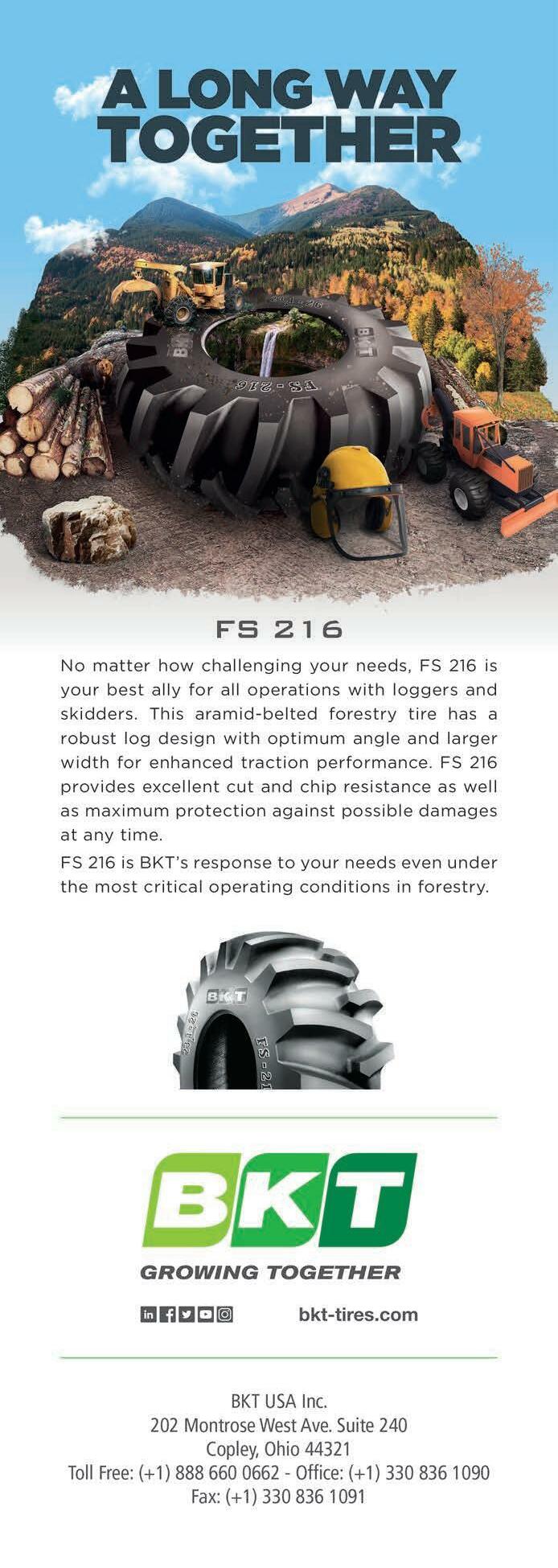
CLICK HERE IF YOU HAVE NOT ALREADY OPTED IN!
By Scott Dane
The pieces for workforce development have been identified, but before they can be put together, the elephant in the room must be acknowledged. Regardless
Workforce Development

of training programs (and there are numerous good ones), the industry needs to be competitive to attract workers.
The existing logging and trucking workforce is aging out at a rate that exceeds
those entering the workforce pipeline. This trend will begin to compromise production in the next five to ten years, if not sooner. This issue is further compounded by the fact that the average logging company owner is in their upper 50s. Unless they have a succession plan, such as passing on the company to the next generation – and many do not – then these companies will exercise their retirement plan: sell their iron (equipment) and discontinue operations.
American Loggers Council member Jim Houdequin, CEO of Lyme Timber Co., testified recently in the Senate Committee on Energy and Natural Resources. He stated, “Employment in logging has declined by 41% from 86,000 in 1990 to under 50,000 today, a decline of 2% per year. However, logging output has remained nearly flat, so reductions in employment have been almost completely offset by increases in productivity.”

Houdequin also described the challenges to workforce recruitment in the logging sector, including low profit margins and wages, physically demanding work, safety challenges, and limited technical training.
So, let’s get back to the elephant in the room. The timber industry is going to remain challenged in its efforts to retain and recruit the workforce necessary for sustainability if it is not competitive— competitive in wages, benefits, working conditions, and stability. In many instances, Starbucks, fast food chains and big box stores offer comparable wages and better benefits than entry-level logging jobs. What determines the wage scale and benefits within the timber industry? The amount that logging companies get paid for the wood they deliver. Most logging companies operate on a 3% profit margin, making it prohibitive, if not impossible, to increase wages or offer competitive benefits, so they offer what they can afford and hope for the best.
“I believe the markets for logging services – principally landowners and mills – are beginning to address profit margins and logger compensation, but many of the other challenges cannot be addressed by the private sector alone,” Houdequinin also said in his testimony cited above. With that premise in mind, the public and private sectors are waking up to the fact that the workforce challenges represent a current and pending threat to the timber and

34 l JANUARY 2023 l Southern Loggin’ Times INDUSTRY NEWS ROUNDUP
Logging
Dane CLICK HERE IF YOU HAVE NOT ALREADY OPTED IN!
As We See It:

CLICK HERE IF YOU HAVE NOT ALREADY OPTED IN!
forest products industries.

Currently, the typical training program in much of the industry consists of a couple of days of best management practices and other topics, then a few hours of instruction on a piece of equipment followed by on-the-job training. With the complexity, technology and cost of today’s logging equipment, that practice is no longer a viable nor a productive process. Training programs such as the Heavy Equipment and Logging Operations (HELO) program at Shasta Community College in California; the Maine Mechanized Logging Operations Program, administered by Northern Maine Community College; Mississippi’s Logging Equipment Operator Academy, administered through Hinds Community College; and others across the country are beginning to pump trained and productive workers into the employment pipeline. Productivity is the key to getting MORE (production) out of LESS (workers).

Promoting the timber industry’s value, opportunities, and the training process is critical to attracting new workers. The American Loggers Council (ALC) has recently received a $100,000 grant as part of a $250,000 Public Image and Workforce Development grant to improve the public understanding of the timber industry while recruiting new mechanized logging equipment operators. ALC will be working with the state associations to pro-
mote their programs, other industry stakeholders to support this initiative, and public and private partnerships to educate the public. Additionally, ALC has been working with the federal government to establish training and investment programs to support the future of the timber industry.
The Senate Committee on Energy and Natural Resources, chaired by Senator Joe Manchin (D-West Virginia) and with ranking member John Barrasso (R-Wyoming), has included three provisions in the bill introduced in September that supports state training programs, onthe-job training, and low-interest loan guarantees for the purchase of mechanized logging equipment. See the official language here:
TITLE III – WORKFORCE SEC. 301. LOGGING WORKFORCE.
(a) TRAINING. —
(1) INTERSTATE TRAINING PROGRAMS. — The Secretary of Agriculture, acting through the Chief of the Forest Service, shall work with States to develop a universal, tiered program to train persons to enter the logging workforce.
(2) ON-THE-JOB TRAINING.—The Secretary concerned shall examine potential ways to facilitate apprenticeship training to increase knowledge and skills in an emerging logging workforce.
(b) MODERNIZING MACHINERY. – Using funds made available under section 40804(b)(3) of the Infrastructure Investment and Jobs Act (16 U.S.C. 6592a(b)(3)), the Secretary of Agriculture determines to be necessary, for the acquisition of mechanized machinery for decreasing injuries in the logging workforce.
In summary, the first step in solving a problem is acknowledging there is a problem. Based on the facts of the aging workforce, the overall reduction in employment within the logging sector, and the lack of new entry-level workers coming into the timber industry, it is clear that workforce shortages will negatively impact timber harvest capacity if they are not addressed. The second step is developing a solution. Workforce development programs at the state levels, federal government support through legislation and public awareness/promotion will collectively increase the opportunities to recruit and train new mechanized logging equipment operators.
The third step in addressing the workforce development threat and challenges is the competitiveness of the timber industry with refer-
36 l JANUARY 2023 l Southern Loggin’ Times
CLICK HERE IF YOU HAVE NOT ALREADY OPTED IN!
ence to comparable industries. This final step in solving the workforce development issue is solely up to the entities that set the rate paid for delivered timber. These entities, the buyers, can invest in the workforce for today and tomorrow. They can ensure the sustainability of the supply chain. They can support the extension of the same level of compensation and benefits as they do for mill workers and other vendors by working with their suppliers to understand their costs.
The pieces to solving the workforce development puzzle are here. The remaining question is whether the players are going to fit the pieces together to safeguard an economically productive wood products industry. The status quo, in the end, I’m afraid, is not sustainable for anyone.
Scott Dane is Executive Director of the American Loggers Council. ALC is a 501(c)(6) trade association representing the interests of timber harvesting and timber hauling businesses across the United States. For more information visit www.amloggers.com.
Northeast TX Receives Heavy Timber Damage

A series of tornadoes that struck northeast Texas in early November damaged timber on more than 10,000 acres; the timber was worth an estimated $13 million.
Storms that tracked across north Texas on November 4 resulted in seven tornadoes, five of which impacted timberland in Bowie, Cass, Henderson, Morris and Red River counties, according to a Texas A&M Forest Service assessment of the damage. One person died as a result of the storm in Morris County.
The damage assessment used forest inventory data collected by Texas A&M Forest Service foresters and technicians as part of the Forest Inventory and Analysis (FIA) program. The data, including forest health, tree numbers, size and condition, was used along with satellite imagery from before and after the storms to estimate damage to timber.
Damaged trees were uprooted, snapped off below the crown or leaning significantly. Most of the damage to timber was on private property.
Damage was estimated for sawtimber—trees at least 9 in. in diameter at breast height; and pole timber—trees smaller than sawtimber but at least 5 in. in diameter at breast height. The value was determined using the most recent Texas Timber Price Trends report.
In Bowie County, an EF-2 tornado with peak winds around 125 MPH stretched for 15.7 miles and was 1,200 yards across at its widest point. The tornado damaged 2,279 acres of
timber: 624 acres of pine forest, 1,327 acres of hardwood forest and 328 acres of mixed pine-hardwood forest. The total value of damaged timber in the county is estimated at $2.7 million.
In Cass County, an EF-1 tornado with peak wind speeds of 110 MPH damaged 3,250 acres of timber along its path of more than 20 miles. The damage included nearly 1,626 acres of pine forest, 1,149 acres of hardwood forest and 476 acres of mixed forest. The total value of damaged timber in the county is estimated at $4.1 million.
Damage in Henderson County was linked to an EF-2 tornado with estimated peak winds of 115 MPH. That tornado tracked more than 16 miles and damaged 194 acres of predominantly hardwood forest with an estimated value of $235,120.
The tornado in Morris County, an EF-2 with estimated peak winds of 125 MPH, tracked 16.9 miles and damaged 1,216 acres: 384 acres of pine forest, 645 acres of hardwood forest and 187 acres of mixed forest, with an estimated timber value of $2.1 million.
In Red River County, an EF-3 tornado with estimated top winds of 150 MPH cut a half-mile path at its widest point and had a 58-mile track of damage, stretching into Oklahoma. The tornado damaged 3,606 acres of timber—816 acres of pine forest, 2,217 acres of hardwood forest and 573 acres of mixed forest—worth an estimated $3.9 million.
American Truckers Cite Fuel Prices, Drivers
The American Transportation Research Institute (ATRI), recently
released its 18th annual top industry issues report, identifying the leading industry concerns including fuel prices, the driver shortage, truck parking, driver compensation, the economy and for the first time, speed limiters.
According to American Trucking Assn. Chairman Harold Sumerford of J&M Tank Lines in Birmingham, Ala., “High fuel prices and finding drivers were two of our industry’s biggest challenges,” and those issues were made more difficult by the economy.
In a year that saw record high fuel costs, fuel prices were ranked as the top industry concern, replacing the driver shortage, which had been the number one issue for five years in a row. In 2022, the driver shortage was the second-ranked issue, followed by the lack of available truck parking. Rounding out the top five this year were driver compensation and the economy.
With the release earlier this year of the Federal Motor Carrier Safety Administration’s Notice of Intent to enter into a speed limiter rule making in 2023, speed limiters ranked in the top ten this year for the first time, coming in ninth overall and fifth among commercial driver respondents. More than 4,200 trucking industry stakeholders participated in this year’s ATRI survey, including motor carriers, truck drivers, industry suppliers, driver trainers, law enforcement, and others.
Stihl Plans Expansion At Virginia Beach
Stihl
Beach, Va. The expansion will add 26,000 sq. ft. of space to an existing building, totaling 86,000 sq. ft. upon completion. The project is also expected to create 15 jobs with an average annual wage of $60,000 to $100,000.
“For nearly 50 years, the City of Virginia Beach has created an ideal environment for Stihl to continue to grow our business and offer meaningful careers to over 2,500 current employees in Hampton Roads,” says Terry Horan, President of Stihl Inc. “We are incredibly proud to be able to continue to expand our Virginia Beach-based manufacturing operations to fulfill the increased demands of our more than 10,000 loyal Stihl dealers nationwide and their customers.”
Virginia Beach Development Authority (VBDA) voted to award Stihl an Economic Development Incentive Program (EDIP) grant of $500,000 for the expansion based on job creation and retention, plus capital investment estimated at $49 million. In addition to increasing its footprint in Virginia Beach, Stihl plans to invest in state-of-the-art equipment and add highly skilled positions to its team, including maintenance mechatronic technicians, process engineers, tool and die makers, project coordinators, and machine operators.
The new project will allow for a third chain saw guide bar production line to be added at 825 London Bridge Road, increasing production capacity. Currently, most chain saw guide bar production takes place at other Stihl locations overseas, but this expansion lays the groundwork for additional manufacturing activity to be moved to the company’s Virginia Beach location.
Southern Loggin’ Times l JANUARY 2023 l 37
plans to invest $49 million
to expand its chain saw guide bar manufacturing facility in Virginia
CLICK HERE IF YOU HAVE NOT ALREADY OPTED IN!
Injured While Failing to
BACKGROUND: On a spring afternoon in the Southeastern U.S., a log truck driver was transporting his second load of the day to the consuming mill. Conditions were clear and dry, so weather was not a contributing factor to the accident.



PERSONAL CHARACTERISTICS: The driver had three years of combined driving experience at the time of the accident and had been in his current position for almost one year.
ACCIDENT: The driver was traveling on a secondary state highway and was following a sedan vehicle. For no apparent reason, the vehicle began to drive erractically and suddenly decided to make an abrupt left-hand turn. The log truck driver was following too close to the sedan and did not have enough time to stop and avoid a rear-end collision with the car. Therefore, the driver elected to steer his truck and trailer to the right and onto the shoulder to avoid striking the car. The driver was able to avoid a collision with the vehicle; however, his trailer traveled into a ditch, flipping the entire truck and trailer onto the
passenger side and spilling the load of roundwood. The driver was wearing his seatbelt. An interview with the business owner revealed that he already had purchased a dash camera system but had yet to install it.
INJURY: The driver was able to call 911 and report the accident. EMS personnel transported him to a regional medical center for further evaluation and treatment for shoulder and arm pain. X-rays and CT scans were performed, and the driver received a referral to an orthopedic surgeon. Upon receiving additional X-rays, orthopedic surgery was scheduled. Alcohol and drug screening was negative.
UNSAFE ACTS/CONDITIONS:

l The driver was traveling too close to the sedan which prohibited him from being able to stop in time to avoid a collision
RECOMMENDATIONS:
l Always maintain a safe following distance
l Be aware of posted speed limits and, if necessary, reduce speed
l Dash camera installation should be a top priority
Maintain
TRUCKING
38 ● JANUARY 2023 ● Southern Loggin’ Times CLICK HERE IF YOU HAVE NOT ALREADY OPTED IN!
Driver
a Safe Following Distance
SAFETY

CLICK HERE IF YOU HAVE NOT ALREADY OPTED IN!
Collision with Train Injures Log Truck Driver
BACKGROUND: On a spring morning in the Southeastern U.S., a log truck driver was starting to transport his second load of the day.
The weather was not a contributing factor to the accident, as conditions were clear and dry.
PERSONAL CHARACTERISTICS: The driver had only been on
the job for 17 months; however, he did have previous truck driving experience. The driver was familiar with the route from the woods to the mill since the logging crew had been operating on this tract for some time.


ACCIDENT: The driver proceeded with caution upon approaching the first set of unguarded rail-
road tracks that crossed the road.
After crossing the tracks, the driver traveled approximately one mile before approaching the second set of unguarded tracks. The truck was traveling approximately 45 mph, which was the posted speed limit. The driver began to become distracted as the glare from the sun started to impact his vision, and at this
exact same moment, his cell phone began to ring. The driver answered the phone call from his boss while using his hands-free device. Both distractions led to the driver failing to notice the flashing signal lights at the railroad crossing warning of an oncoming train. As the driver began to cross the tracks, the locomotive collided with the cab, causing the train to derail. The locomotive was traveling at a low rate of speed, but the collision caused the truck to spill its load of logs and be pushed approximately 60 feet down the tracks. The owner heard the collision over the phone and, after several attempts to contact the driver, was finally able to connect with him and learn more details about the precise location of the accident.
INJURY: When the business owner arrived at the accident scene, EMS had already started transporting the injured truck driver and locomotive engineer to a regional medical center by ambulance. The truck cab was crushed, but the driver was protected by the heavy-duty headache rack, which prevented logs from penetrating the cab. The driver was admitted to the ICU and diagnosed with four shattered ribs and a liver laceration. He was released from the hospital two days later for an 8week in-home recovery period. Drug and alcohol screening was negative.
UNSAFE ACTS/ CONDITIONS:
l The driver failed to yield the right of way to oncoming train by disregarding the flashing warning signal.
l The driver was operating a moving vehicle while distracted and not paying attention to his surroundings.
RECOMMENDATIONS:
l Always be aware of your surroundings and avoid any distractions while driving.
l Use “Do Not Disturb” mode or a similar safety feature on smartphones to eliminate the temptation to answer calls or texts while driving.
l Stop a safe distance away from the tracks at railroad crossings to ensure the tracks are clear of oncoming trains.
Supplied by Forest Resources Assn.
40 ● JANUARY 2023 ● Southern Loggin’ Times CLICK HERE IF YOU HAVE NOT ALREADY OPTED IN!



Southern Loggin’ Times ● JANUARY 2023 ● 41 CLASSIFIED AD RATES: Classified advertising rates are $55 per inch. Space is available by column inch only, one inch minimum. DEADLINES: Ad reservation must be received by 10th of month prior to month of publication. Material must be received no later than 12th of month prior to month of publication. CONTACT: Call Bridget DeVane at 334-699-7837, 800-669-5613, email bdevane7@hotmail.com or visit www.southernloggintimes.com IRONWORKS TOLL FREE: 1-800-669-5613 6209 2687 CLICK HERE IF YOU HAVE NOT ALREADY OPTED IN!


42 ● JANUARY 2023 ● Southern Loggin’ Times WANT TO PLACE YOUR CLASSIFIED AD IN IRONWORKS? CALL 334-699-7837, 1-800-669-5613 OR EMAIL: CLASS@SOUTHERNLOGGINTIMES.COM 5078 4433 CLICK HERE IF YOU HAVE NOT ALREADY OPTED IN!


Southern Loggin’ Times ● JANUARY 2023 ● 43 WANT TO PLACE YOUR CLASSIFIED AD IN IRONWORKS? CALL 334-699-7837, 1-800-669-5613 OR EMAIL: CLASS@SOUTHERNLOGGINTIMES.COM 2891 2687 CLICK HERE IF YOU HAVE NOT ALREADY OPTED IN!



44 ● JANUARY 2023 ● Southern Loggin’ Times WANT TO PLACE YOUR CLASSIFIED AD IN IRONWORKS? CALL 334-699-7837, 1-800-669-5613 OR EMAIL: CLASS@SOUTHERNLOGGINTIMES.COM 6288 13189 7393 CLICK HERE IF YOU HAVE NOT ALREADY OPTED IN!
redundancy built in to help handle maintenance, these silos allow the facility to perform work without stopping the press hall. The silos are able to feed both lines of the press hall, which is broken up as line one with CPM presses one through six and line two with CPM presses seven through twelve. Each press uses 70 mm dies, with a capacity of 5.5 tons/hour maximum. Herndon admits that on good days the facility reaches five tons/hour, saying this is truly a year to dive into the reliability of the process.
There is one cooler for each pair of presses, to help cure pellets. Shaker screens remove fines, dropping to a conveyor that re-enters the process. Accepted pellets travel on a bucket elevator into one of four Chief pellet silos.
Load out is carried via another bucket elevator to the truck load out building. All production is hauled via truck to the Port of Port Arthur, just an hour and a half away from Woodville, mainly using company owned trucks.

Kice Industries’ Process Group engineered and designed dust collection and process air systems required for the wood grinding and pelleting. This work included designing various dust collection
pick-up points, laying out duct runs to various points, overall dust collection manifolds, and dust collection equipment layout of the various baghouse filters. Kice’s complete engineering package included construction drawings of each system as well as installation and startup.

Kice-manufactured centrifugal fans were employed as the air movers along with the Kice CR and VR Series baghouse filters used to capture the dust. Kice airlocks and PD blowers were integral to these and other processes throughout the facility. Any material not big enough for the baghouses goes to an airlock, screw and back into the process.
Additionally, a Nestec RCO treats VOCs off the process— adding a layer of redundancy in VOCs control with both the Nestec RCO and TSI RTO. The facility utilizes a GreCon fire detection system.
Maintenance, Safety


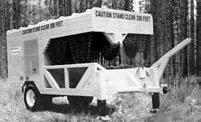
The team is making a concerted effort to address leakage—if something needs to be fixed, it’s taken down and fixed. Herndon says this is in line with his desire to bring more pride to the plant and create excellent, clean working conditions. He

adds, “I want everyone to feel good when they come to work. Their tools are in the right place. All that stuff is rolled into helping us be safe and do a good job. We’re continuing to work on it.”
The facility has basic policies and procedures to keep everyone safe, and the plant in the best condition it can be. Ansley and Herndon are in the process of reviewing and refreshing the safety programs, to make sure everything is handled in a safe manner. They’ve also rolled out safe work practices that are more orientated toward the pelletizing industry.
Ansley says that anyone can say safety is a core value, but for him, it is more than just expecting someone to do something specifically. Instead, he draws it back to equipping employees with the right

tools to do their jobs—whether it be a literal tool handed to them, a program to report near misses, or a service program to put in work orders and work requests. These are things that he believes might not on the surface level seem like “safety” but are part of the safety culture that will drive change to the organization.

He believes, “These changes are what leads to a highly reliable facility because you focus on fixing problems that can lead to safety issues. It all ties together. Earl and I know what this plant can be. We’re on a path; it’s getting there.
For the people that have been here for 10 years, it’s getting them to a spot where they see it and see it come to fruition. I am excited about the journey and where we are going.”
Southern Loggin’ Times ● JANUARY 2023 ● 45 WANT TO PLACE YOUR CLASSIFIED AD IN IRONWORKS? CALL 334-699-7837, 1-800-669-5613 OR EMAIL: CLASS@SOUTHERNLOGGINTIMES.COM Straightening and balancing service All makes CARVER SAWDISK REPAIR Washington, NC 252-945-2358 566 FELLER BUNCHER SAWDISK REPAIR RECONDITIONED DELIMBINATORS!! In addition to new machines, CHAMBERS DELIMBINATOR, INC. now has factory reconditioned DeLimbinators. These units have been inspected, repaired, and updated as needed. Call us and we will help you select a DeLimbinator for your needs. WE ALSO BUY USED DELIMBINATORS Call: 662-285-2777 Email: chambersdelimbinator@gmail.com 1123 EUREKA! EUREKA! EUREKA! OWNERS HAVE OVER 30 YEARS COMBINED EXPERIENCE! We can save you money on Saw Teeth. Hundreds of satisfied customers. Rebuilt Exchange or New. We specialize in rebuilding Koehring 2000, Hurricana, Hydro Ax split teeth and all other brands. Call Jimmy or Niel Mitchell. Quantity Discounts! EUREKA SAW TOOTH CO., INC. 4275 Moores Ferry Rd. • Skippers, Virginia 23879 PH./FAX (day) 1-434-634-9836 or Night/Weekends • 1-434-634-9185 NOW ACCEPTING CREDIT CARDS 7180 2583 FOR SALE 2014 TIGERCAT 620E SKIDDER Dual arch & winch, 30.5 rubber...POR Maplesville, AL Call or Text Zane 334-518-9937 3939 FOR SALE 10' Marden Chopper with Good Blades Bearings, tongue and hitch all good........$35,000 Call Bill @ 850-258-8774 13842
SLT 21 ➤
Jason Ansley
CLICK HERE IF YOU HAVE NOT ALREADY OPTED IN!
Earl Herndon
American Truck Parts 32 888.383.8884
Around The World Salvage 42 936.634.7210
Bandit Industries 19 800.952.0178
Big John Trailers 5 800.771.4140
BITCO Insurance 27 800.475.4477
BKT USA 33 888.660.0662
Caterpillar Dealer Promotion 11 919.550.1201
Despino Tire 23 318.445.4561

Eastern Surplus 26 855.332.0500
FMI Trailers 12 601.508.3333
Forest Chain 32 800.288.0887
Forestry First 44 803.708.0624
Forestry Mutual Insurance 3 800.849.7788
G & W Equipment 36 800.284.9032
Golden Rule Equipment 29 717.933.4007
Hawkins & Rawlinson 34 888.822.1173
Interstate Tire Service 44 864.947.9208
Iron Horse Auction 40 800.997.2248
Kaufman Trailers NC 2 336.790.6807
Mike Ledkins Insurance Agency 24 800.766.8349
LMI-Tennessee 17 800.467.0944
Loadrite Southern Star 32 256.270.8775
Logger Associations 26
Magnolia Trailers 35 800.738.2123
Maxi-Load Scale Systems 18 877.265.1486
McCarthy Tire Service 27 443.602.6636
Midsouth Forestry Equipment 38 870.226.0000
Moore Logging Supply 38 888.754.5613
Morbark 1,7 800.831.0042
Olofsfors 25 519.754.2190
Pitts Trailers 48 800.321.8073
Ponsse North America 13 715.369.4833
Prolenc Manufacturing 40 877.563.8899
Quadco Equipment 22 800.668.3340
Quality Equipment & Parts 42 386.487.3896
Southern Loggers Cooperative 30 318.445.0750
Stribling Equipment 43 855.781.9408
Tidewater Equipment 41,43 912.638.7726
Timberblade 31 519.532.3283
TraxPlus 23 601.635.5543
W & W Truck & Tractor 39 843.761.8220
Wallingford’s 36 800.323.3708
Waratah Forestry Attachments 47 770.692.0380
Waters International Trucks 44 601.693.4807
J M Wood Auction 33 334.264.3265
Yancey Brothers 30 800.282.1562
COMING EVENTS
January
10-11—Missouri Forest Products Assn. winter meeting, Courtyard Marriott, Jefferson City, Mo. Call 573-634-3252; visit moforest.org.
February
22-26—Appalachian Hardwood Manufacturers annual meeting, Ponte Vedra Inn & Club, Ponte Vedra, Fla. Call 336-885-8315; visit appalachianhardwood.org.
24-26—South Carolina Timber Producers Assn. annual meeting, DoubleTree Resort by Hilton, Myrtle Beach, SC. Call 800-371-2240; visit scloggers.com.
March
8-10—2023 SLMA & SFPA Spring Meeting & Expo, Hyatt Regency Savannah, Savannah, Ga. Call 504443-4464; visit slma.org.
28-30— Kentucky Forest Industries Assn. annual meeting, Embassy Suites, Lexington, Ky. Call 502-695-3979; visit kfia.org.
30-April 1—Southeastern Wood Producers Assn. annual meeting, The Okefenokee Fairgrounds, Waycross, Ga. Call 904-845-7133; visit swpa.ag.
southernloggintimes.com
April
26-28—Virginia Forestry Summit, Williamsburg Lodge, Williamsburg, Va. Call 804-278-8733; visit vaforestry.org.
August
11-12—Southwest Forest Products Expo, Hot Springs Convention Center, Hot Springs, Ark. Call 501-2242232; visit arkloggers.com.
17-20—Virginia Loggers Assn. annual meeting, Hotel Roanoke, Roanoke, Va. Call 804-677-4290; visit valoggers.org.
23-25—Forest Products Machinery & Equipment Expo, Music City Center, Nashville, Tenn. Call 504443-4464; visit sfpaexpo.com.
September
15-16—Kentucky Wood Expo, Masterson Station Park, Lexington, Ky. Call 502-695-3979; visit kfia.org.
22-23—Mid-South Forestry Equipment Show, Starkville, Miss. Call 800-669-5613; visit midsouth forestry.org.
May 2024
12-13—Wood Bioenergy Conference & Expo, Omni Hotel at CNN Center, Atlanta, Ga. Call 334-834-1170; visit bioenergyshow.com.
17-18—Expo Richmond 2024, Richmond Raceway Complex, Richmond, Va. Call 804-737-5625; visit exporichmond.com.
August 2024
20-23—IWF 2024, Georgia World Congress Center, Atlanta, Ga. Call 404-693-8333; visit iwfatlanta.com.
46 ● JANUARY 2023 ● Southern Loggin’ Times
ADLINK is a free service for advertisers and readers. The publisher assumes no liability for errors or omissions. A ● D ● L ● I ● N ● K ADVERTISER PG. NO. PHONE NO.
CLICK HERE IF YOU HAVE NOT ALREADY OPTED IN!
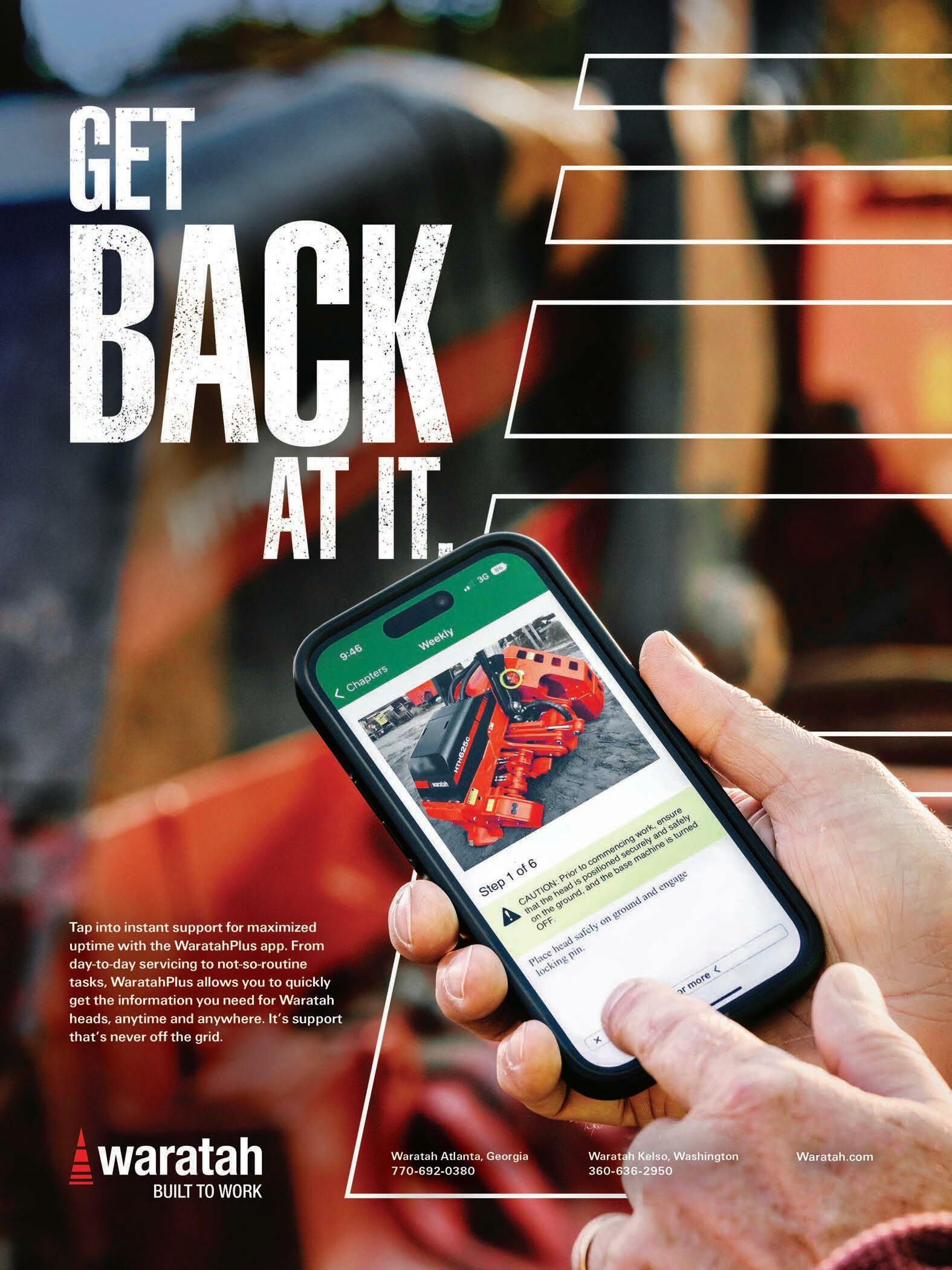
CLICK HERE IF YOU HAVE NOT ALREADY OPTED IN!
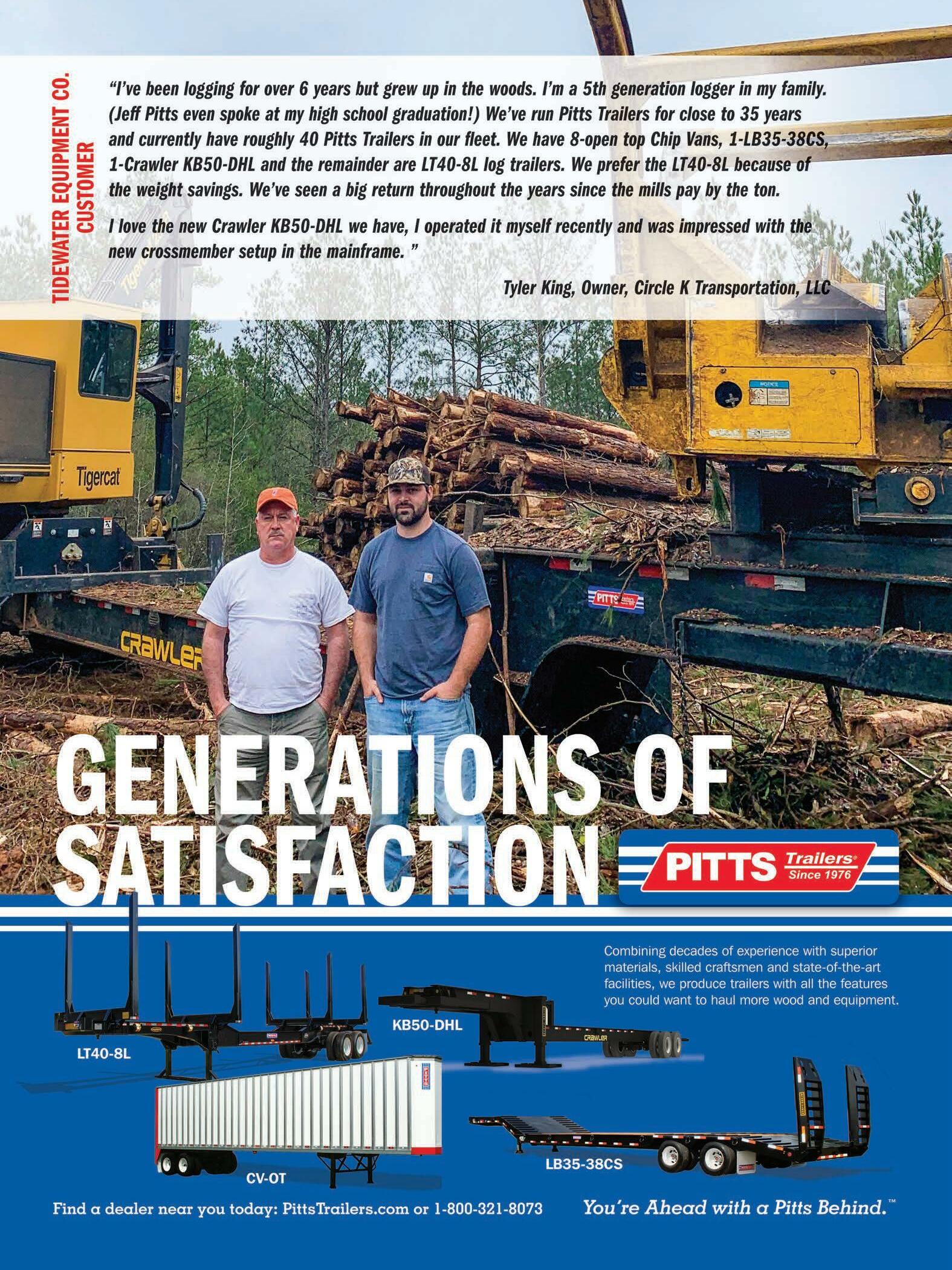
CLICK HERE IF YOU HAVE NOT ALREADY OPTED IN!

































































 Olofsfors is a Swedish based company founded in 1762 with North American operations in Brantford, Ontario, Canada. Olofsfors Inc. specializes in attachments and accessories for cut-to-length machinery. The prod-
Olofsfors is a Swedish based company founded in 1762 with North American operations in Brantford, Ontario, Canada. Olofsfors Inc. specializes in attachments and accessories for cut-to-length machinery. The prod-


















































